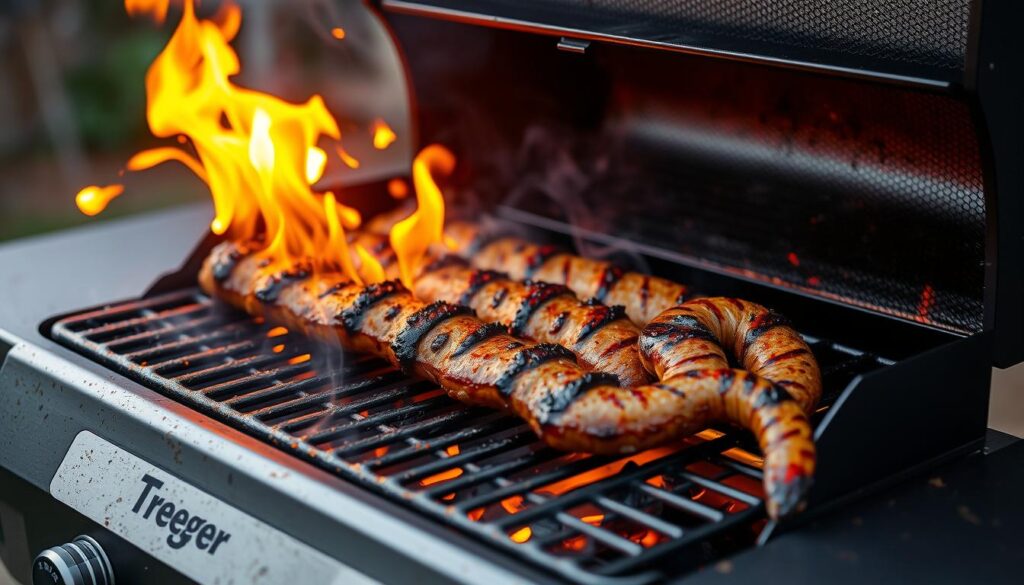Cooking snake is an adventure that combines culinary exploration with traditional techniques. For centuries, various cultures have incorporated snake meat into their cuisine, valuing it for its unique flavor and nutritional benefits.
We explore the fascinating world of cooking snake, a practice that not only offers a novel protein alternative but also challenges common misconceptions about exotic food. With a flavor profile often likened to chicken, yet possessing a distinctive nutty undertone, snake meat is surprisingly versatile on the grill.
Proper cooking techniques are essential for both food safety and maximizing the unique texture and flavor of this exotic meat. Through this guide, we aim to equip both experienced outdoorsmen and culinary enthusiasts with the knowledge to confidently prepare snake dishes.
Key Takeaways
- Understanding the safety aspects of handling and cooking exotic meats.
- Exploring traditional and modern techniques for cooking snake.
- Discovering the unique flavor profile and nutritional benefits of snake meat.
- Learning how to maximize the texture and flavor through proper cooking methods.
- Addressing common misconceptions about cooking and consuming snake.
Understanding Snake Meat: A Unique Culinary Experience
As we venture into the realm of exotic meats,snakestands out as a particularly interesting specimen. Snake meat has been a part of various cuisines around the world, offering a unique gastronomic experience. It’s a culinary adventure that combines tradition with the thrill of trying something new.
Nutritional Profile and Taste Expectations
Snake meat is not only a delicacy but also a nutritious option, being high in protein and low in fat. The taste is often described as similar to chicken or fish, with a slightly sweet flavor profile. When prepared correctly, snake meat can be a delightful addition to any meal.

Types of Edible Snakes in North America
North America is home to several ediblesnakespecies. The rattlesnake family, including the Western Diamondback and Timber Rattlesnake, is among the most commonly consumed. The non-venomous Black Rat Snake, found throughout the eastern and midwestern United States, offers substantial meat yield. Other species like water snakes, though less commonly eaten, are also viable options.
By understanding the different types of snakes and their characteristics, we can better appreciate the culinary potential ofsnakemeat.
Safe Handling and Preparation of Snake Meat
The safe handling and preparation of snake meat are essential for preventing foodborne illnesses. When handling exotic meats like snake, it’s crucial to follow strict safety protocols to avoid contamination and ensure a safe dining experience.
Proper Snake Acquisition and Safety Precautions
We emphasize the importance of acquiring snakes from reputable sources and handling them with care. Using disposable gloves when handling raw snake meat is a critical precaution, as snakes can carry Salmonella bacteria. For detailed guidance on acquiring and handling snakes, we recommend consulting resources like expert tutorials.
How to Skin and Clean a Snake
To skin and clean a snake, we follow a meticulous process. First, we wear disposable gloves to prevent direct contact with the snake’s potentially contaminated skin. We then carefully skin the snake, taking care not to puncture the internal organs, which could contaminate the meat. After skinning, we thoroughly wash the meat and our utensils with hot, soapy water.

Preventing Contamination and Food Safety
To prevent contamination, we keep raw snake meat separate from other foods and utensils. Dedicated cutting boards and utensils are sanitized after use, preferably with a bleach solution or a high-temperature dishwasher cycle. Cooking the snake meat to an internal temperature of at least 160°F (71°C) is non-negotiable for food safety. We also minimize the time between cleaning and cooking, or promptly refrigerate the meat at temperatures below 40°F (4°C).
Expert Techniques for Grilled Snake
Mastering the art of grilling snake involves understanding the specific requirements for preparing and cooking this exotic meat. Grilling snake can be a unique culinary experience, offering a flavor profile that is both tender and rich.

Preparing Snake Meat for the Grill
To prepare snake meat for grilling, we start by cutting it into manageable pieces, typically around 2 inches in length. This size ensures even cooking and makes handling easier. Before grilling, we recommend marinating the snake pieces to enhance flavor and tenderize the meat.
Temperature and Timing Guidelines
Grilling snake requires careful attention to temperature and timing. We suggest grilling at a medium-high heat, turning the snake just once, after 2-3 minutes per side. This method ensures a nice char on the outside while keeping the inside tender.
Seasoning and Marinade Recommendations
For seasoning, a mix of herbs and spices that complement the natural flavor of the snake works well. A marinade with ingredients like egg white and a pepper and sweet cornmeal mix can add depth and a satisfying crunch. Experimenting with different marinades can help find the perfect balance of flavors.
Alternative Cooking Methods: Smoking and Frying
While grilling is a popular method for cooking snake, other techniques like smoking and frying are also worth exploring. Smoking at a low temperature (180-200°F) for 3-4 hours can impart a rich, distinctive flavor. Frying, on the other hand, requires heating oil to 350°F and cooking the snake pieces for just 2-3 minutes per side, until golden.
Serving Your Perfectly Grilled Snake
To fully appreciate the flavor and texture of grilled snake, it’s essential to serve it correctly. We recommend removing the wooden skewer and cutting the snake into individual 4- to 5-inch pieces for a more manageable and visually appealing presentation.
Alternatively, you can serve the snake on a rustic wooden board or platter, allowing your guests to pick the meat from the bones. Most of the meat lies along the backbone, similar to a backstrap, but you can also find meat around the rib bones and along the belly.
To enhance the dining experience, consider pairing grilled snake with tangy sauces like chimichurri or aioli, and sides such as grilled vegetables or cornbread. A chilled craft beer or dry white wine complements the richness of the grilled meat while cutting through its subtle flavors.
For an elevated presentation, garnish the platter with fresh herbs, lemon wedges, and edible flowers. This not only honors the unique culinary tradition of eating snake but also creates a visually stunning dish that will be a conversation starter at any gathering.


